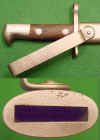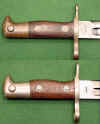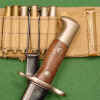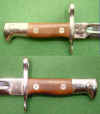Gary Cunningham's
Bayonet Point's
Updated Oct.1, 2003
Bayonet Points #12 - October, 2003
Off and on in my emails, I get questions about the Model 1892 "Krag" bayonets and scabbards. In the first three sections of The American Military Edged Weaponry Museum section on this website there are fine photos of the very hard to find Cadet versions of this bayonet. Since I am not fortunate enough to have a specimen of this bayonet in my collection, I will refer those who are interested to those photos and descriptions.
By the time I became seriously interested in collecting bayonets, some of them were already out of my price range. One of these is the earliest of the Model 1892s, the fully blued bayonet dated 1894 or 1895. Due to the fear that the heat of the niter bluing process would damage the temper of the blade, bluing of the blade was stopped in April 1895. How many blued bayonets were produced is not known for certain, but the number was probably between 8 and 10 thousand.
Although I have seen a few for sale over the years, I have never been able to combine the opportunity with enough money to make a purchase. They are especially scarce since the bulk of them were either recalled and polished, or polished during a later reconditioning. Even finding one of the 1894 dated bayonets that has been polished bright can be difficult and fairly expensive if the condition is very nice.
Even scarcer is the first type scabbard used with these bayonets. The earliest version had the opening in the mouth slightly narrower on one end than the other, creating a trapezoidal shape that meant the blade could be inserted only in one way. The difference in size is not very great and you have to look fairly close to see it. The narrow end is about .225 inch wide and the wide end is about .260 inch. This was changed in July of 1895 to a rectangular opening that allowed the blade to be inserted either way. As these scabbards are quite hard to find and expensive, I had reconciled myself to the likelihood that I was unlikely to ever be able to own one on my budget.
However, about a year ago one was put up for auction on Ebay. As the condition was rough, with no bluing left and some light pitting overall, I was able to purchase it at a reasonable price. Then came the feeling that I really needed an 1894 date bayonet to go in the scabbard. I posted a "wanted" notice on a couple of the Internet blade forums and checked dealer lists and ads. I found a few, but all were priced more than I could justify, and were in most cases somewhat nicer condition than the scabbard.
A few weeks later a gentleman posted a notice on one of the forums that he had seen an 1894 dated bayonet in a local shop, priced rather reasonably since the condition was not real nice. I contacted him and he picked it up for me and sent it on. It is indeed not in the best of condition, but it matches the scabbard so well it looks like they have been together forever. I am sure that if I didn't tell someone the facts, they would assume they are a matched set.
Holding them gives one a feeling that they could have "been there" in the jungles of the Philippines during the Spanish-American War or the Insurrection, but of course the likelihood is that they were stored in someone's basement or garage and forgotten for 50 years.
![]()
Click on thumbnail for full size photo
1894 Dated Model 1892 Bayonet With Early Scabbard
Another feature of the early scabbard is that the belt hook rotates 360 degrees on the body stud. The complaint was made that this allowed the scabbard to turn upside down on the belt and for the bayonet to fall out of the scabbard, although there are metal springs inside the mouthpiece to provide a certain degree of friction to help prevent this.

Click on thumbnail for full size photo
Early Scabbard Showing the Belt Hook Swivel and the Scabbard Mouth
Prior to November of 1899, the walnut grips were sanded smooth and were even with the tang and pommel. The attaching rivets were ground smooth against the grip washers. This involved a great deal of handwork in finishing, and after November 1899 the grips were finished slightly oversized so they overhang the tang and pommel slightly. They were not sanded smooth, and some of the cutter marks will show as grooves and ridges. The rivets were peened in a dome over the washers. Due to rebuilds, blades dated prior to 1900 can be found with the later grips and rivets.

Click on thumbnail for full size photo
Above: Pre November, 1899 Grip and Rivet Contours
(Note - the date of 1897 is stamped upside down to the normal orientation)
Below: Post November, 1899 Grip and Rivet Contours
In late 1896 the mouthpiece springs were strengthened, and a pin stop was added to the washer on the belt hook so that the rotation was limited to about 50 degrees to either side. Some collectors refer to this as the Model 1896 scabbard, although that designation was not official.

Click on thumbnail for full size photo
Second Type Scabbard With Pin Added To Limit Rotation
There are three versions of the belt hook that were used with the scabbard over its period of use. The first type is a simple hook, which was used until 1899.

Click on thumbnail for full size photo
Three Types of Belt Hooks Used on the Krag Scabbards
Left: The Single Hook Made From 1894 to 1899
Center: The Wide Pivoting Wire Keeper Made From 1899 to 1905
Right: The Narrow Pivoting Wire Keeper Made in 1905
The second type was adopted in 1899 (and referred to in Ordnance reports as the Model 1899), and had a pivoting double wire catch that fit over one of the loops of the web cartridge belt. The new loop was developed by Captain (later Colonel) Rogers Birnie of the Ordnance Department.
This design is said to have came about due to complaints received during the Spanish-American War that under some conditions the scabbard hook could disengage from the belt and the scabbard be lost (it will not come loose if the bayonet is in the scabbard). Also, the edges of the belt hook tended to fray the belt and cartridge loop. Having put the scabbard on two or three different looped belts, I can say from experience that the scabbard is fairly hard to put on and although not too difficult to take off, I don't feel that it would readily come off even under strenuous conditions. It is my opinion that it actually was designed to be more easily fitted and removed, and also could be used on belts other than the web cartridge belt, as well as being less likely to damage the belt.
The pin limiting the movement of the hook proved to be too fragile, and the Model 1899 used a tab bent on the bottom of the hook which traveled in a slot in the stud on the body. This also limited the motion to about 50 degrees to either side of center.

Click on thumbnail for full size photo
The Motion Limiting Tab On The Model 1899 Scabbard
The third type was manufactured in 1905, apparently by converting earlier scabbards, and is the same belt hook being used on the Model 1905 bayonet scabbard. This was made so that the wires would pass between two of the pockets of the new cartridge belt designed for the Model 1903 cartridge carried in 5 round clips. Krag cartridges could be carried loose in the pockets, and since it was not expected that the earlier looped cartridge belts would continue to be made, this would allow issue of the new belt for the Krag rifle if needed. It is unlikely that this last version of the scabbard hook saw any service in the Regular Army, although it probably was used by the Militia and possibly the Navy, both of which kept the Krag in service long after the Army had switched to the Model 1903 rifle.

Click on thumbnail for full size photo
The First Type Belt Hook In Use On A Web Double Loop Krag Cartridge Belt

Click on thumbnail for full size photo
The Second Type Belt Hook In Use On A Web Single Loop Krag Cartridge Belt
It may be noted that the bayonet in this photo has a number (690973) hand stamped on the side of the guard. The number is far too high to have been a Krag rifle number, which only went to about 450,000. I have heard two or three possible explanations, but none that have any documentation. It is almost certain that this was done outside of the US military, possibly in a foreign country. I have seen two others so numbered over the years, so it isn't a one of a kind, but is uncommon enough that it probably wasn't done on a large scale. Does anyone have any information on this numbering of Krag bayonets?

Click on thumbnail for full size photo
The Third Type Belt Hook In Use On A Pocketed Web Cartridge Belt
While in the process of writing this article, I found a late Cadet bayonet on eBay (actually there were two of them). This late style is a standard Krag bayonet that was chromed and new grips installed. This is shown in The American Military Edged Weaponry Museum section of this website at
http://www.usmilitaryknives.com/amewm_3.htmAlthough I have not determined when the process of chrome plating the bayonets began for use at West Point (and possibly elsewhere), this continued into the 1960s until the changeover to the M14 rifle at the Point. Frank Mallory, in his book The Krag Rifle Story states that bayonets were sent from West Point to Frankford Arsenal in 1929 and in 1935 (1,400 in that year) to be plated. The chromed Krag was used with the Model 1903 rifles and the M1 rifle as it handled and balanced well on them, and looked good on parade.
I don't browse eBay as much as I used to, especially in the summer months when it seems there is always something else to be doing. I do try to check it out first thing in the morning before I go to work, but with over 1000 bayonets at any time, I am sure I miss a lot of good ones. Last week I was just browsing and noted a Krag bayonet advertised as chromed, so I took a look. The description stated: "1901 KRAG BAYONET. Beautifully chromed bayonet. Don't know if it was honor guard or American Legion, VFW or just someone who wanted a chrome bayonet, but excellent job. Metal scabbard is painted black." The photos were not great, but it appeared that it might be a Cadet so I emailed for more details. The answers sounded good, so I followed it and placed a bid just to see what would happen. At the end, I was the high bidder at $95 with shipping.
I received it yesterday and everything looks good. The scabbard is indeed painted a low gloss black, and is fitted with the Belt Adapter used with the leather waist belts. I have heard that the scabbards were painted as an easy refinish, and the black goes well with the black stripes on the uniforms. The leather belt adapter allows the use of the standard bayonet hanger with garrison or dress belts. Another type of scabbard for the Cadets, the Hoffman design, used a leather hanger fitted to a stub of the regular metal hook - see the link above to the cadet scabbards on this site. This type did not hold up well as the leather would come loose from the metal stub and was hard to replace. The leather adapter solved that problem and was easily fitted to the standard scabbard hook.
The smooth grips are well fitted, and attached with chromed flat head bolts and spanner nuts. The chroming is of very good quality and shows little wear. I am happy with it, and feel there is a very high probability that this is one of the true cadet versions.

Click on thumbnail for full size photo
Grips Of The Krag "Cadet" Bayonet

Click on thumbnail for full size photo
The Scabbard Showing The Belt Adapter
Note in the photo of the back of the belt adapter that there is another slot below the one in use. This allows the adapter to be used with the 1905 style belt hook, which is longer than the 1899 type. The earlier ones made and marked by Rock Island were specific to the particular hanger.
I happened to notice at the same time that there was a similar bayonet for sale, but advertised as a Cadet model. The ad read: "This is a original US Model 1892-1898 Krag Cadet Bayonet. All metal is bright plated. The blade is marked US on one side & 1898 on the other side. The bayonet is in Excellent condition & is one of the best I have ever had. No rust spots & has all the original finish." The photos indicated that this was also likely to be one of the late Cadet models. This one had no scabbard, and sold a couple of days later for a little over $200 plus shipping. So it does pay to watch and read all of the ads, as a "goodie" can sometimes yet be had if you know what you are looking at.
The Detroit Gasket and Manufacturing Company M3 Scabbard
For several years, collectors have assumed that the M3 scabbard with the "Lazy S" mark under the US mark on the throat was made by Detroit Gasket. This was based on the facts that the throat was not a Beckwith, the only other quantity maker of the scabbard. Also, the material of the body was consistent with the knowledge that the Detroit Gasket scabbards were made of a different material than that used by Beckwith, one which did not hold paint well. But we had no firm information to back up this assumption.
Last week I received a very welcome email from Mr. G.W. Diehl, a retired employee of Detroit Gasket and Manufacturing Company. He informed me that: "The marking on the subject scabbard made by the Detroit Gasket & Mfg. Co. is not a "lazy S" but rather their logo - a "D" connected to and over a "G". Somehow the marking shown in reversed. If seen correctly, the "D" and "G" are apparent." Well, I looked and sure enough, if you "flip" the marking, it is indeed a D over and connected to a G. Many thanks Mr. Diehl - all of us appreciate your comment.

Click on thumbnail for full size photo
The "Lazy S" Marking On The Detroit Gasket Manufactured M3 Scabbard Throat

Click on thumbnail for full size photo
The "Lazy S" Mark Rotated And Inverted - The Detroit Gasket Logo